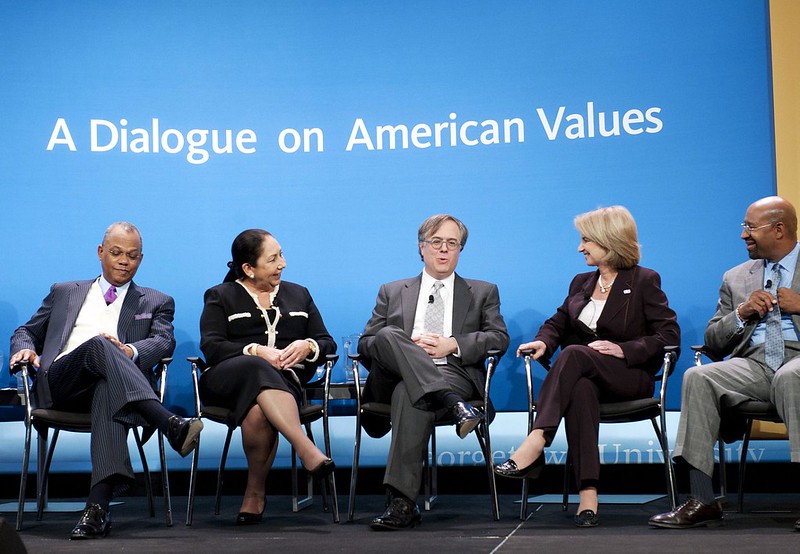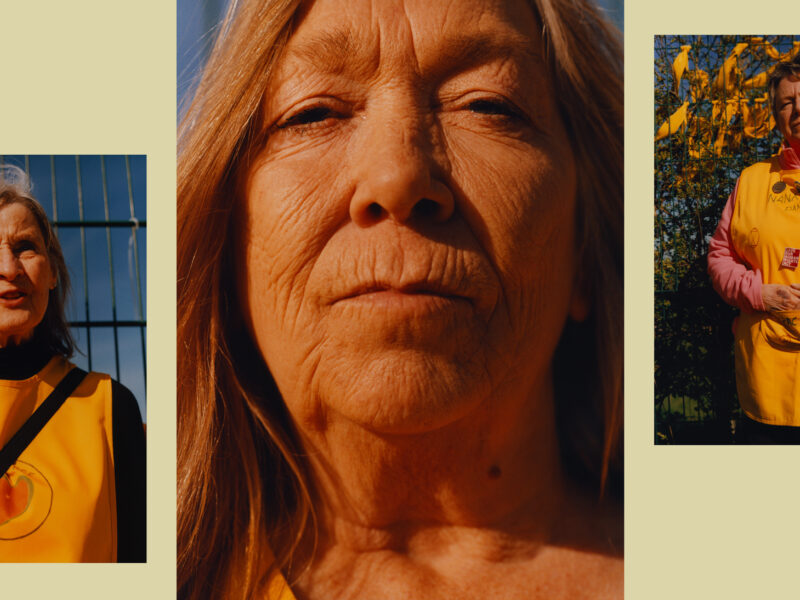After years of shallow coverage, legacy media in the U.S. are finally engaging critically with white evangelical ideology. Read part one of this three-part series on the trajectory of the Christian Right; and part two.
The would-be respectable evangelical elite, which includes Beltway-based media analysts and political lobbyists who rose to power under the Reagan and Bush presidencies, have positioned themselves as Never Trumpers. But they have failed to take responsibility for their role in waging the culture wars that led to Donald Trump’s election to the presidency and subsequent consolidation of power, which happened largely on the back of the Christian Right’s unswerving support. And while majorities of all white Christian demographics voted for Trump in 2018, white evangelicals led the pack and remain America’s most Trumpist demographic.
While elite evangelicals like Peter Wehner, Michael Gerson, and David French all find Donald Trump a bridge too far, they have long supported the kind of Christian schooling that serves to indoctrinate children in patriarchal and anti-LGBTQ views, toxic purity culture, Christian nationalist history, young earth creationism, and right-wing political ideology. They also share their rank-and-file coreligionists’ obsession with banning abortion, which has served since the late 1970s as a proxy for white supremacism, as white evangelicals and other right-wingers invested in respectability felt compelled to give up overt support for racial discrimination.
Concentrated in the Republican Party since the late 1960s, white Christian America has never had to face up to its crimes. These range from supporting slavery and Jim Crow, to supporting the war crimes committed abroad post-9/11 under the presidential administration of George W. Bush—along with complicity in a predictable spike in hate crimes against Muslims at home. More recently, they include complicity in anti-Black terrorism and support for the voter suppression and “law and order” politics that Trump is counting on to win a second term in office.
Thanks to white evangelicals’ unwavering Trump support, “respectable” evangelicals have failed to keep a lid on the quiet part of their ideology; as a result, they have begun to lose control over the image of the Christian Right in the media, which means they can no longer direct the national conversation about evangelical Christianity as effectively as they used to. Although progress in this regard has been uneven, and particularly limited in major legacy outlets, a significant shift is detectable. Even if Trump loses the election this November, I hope the presence of diverse voices and critical perspectives on evangelicalism will continue to increase in the media, so that the public can begin to deal seriously with the threat authoritarian Christianity poses to democracy and human rights.
The primary barrier to covering right-wing Christianity fairly is the legacy media’s unspoken taboo on careful, critical examination of views that prominent Christians say are the product of “sincerely held religious belief.” This lack of critical coverage allows conservative Christians to get away with insisting that they are above politics; and because reporters for cable news and major media outlets fail to challenge the claim, they reinforce the white Christian supremacism that has become such an important political force.
Like freedom of the press, religious freedom is an important First Amendment right. But when believers use their faith as a bludgeon to attack othered groups and to prevent equal accommodation of members of those groups in the public square, we have moved beyond the bounds of a truly democratic approach to pluralism.
Because white evangelicals are using their religious beliefs to mobilize politically, the media must hold them to account just as they would any political movement. Advocates of democracy and human rights must make the Christian supremacism that pervades American politics visible; this is the most effective means to reclaim a robustly democratic understanding of religious liberty from the Christian Right, which defines it as their right to impose their religious beliefs on a public that does not share them.
Since 81 percent of white evangelicals voted for the flagrantly impious Trump in 2016, journalists, pundits, and commentators have scrambled to explain why. The initial flood of commentary about white evangelical support for Trump was ill-informed, presenting the Christian Right through the lens of hypocrisy; while this criticism was shallow, it was important in that it indicated the extent to which respectable evangelicals were losing their control of the Christian Right’s media image.
Eventually, critical hashtags created by former evangelicals (including myself) like #ExposeChristianSchools and #ChurchToo garnered coverage in outlets like New York Times, Washington Post, and Associated Press. Liz Kineke, a religion journalist, produced Deconstructing My Religion, a documentary about ex-evangelicals for CBS Religion (I appear in the film).
More recently, New York Times religion reporter Elizabeth Dias wrote: “Evangelicals did not support Mr. Trump in spite of who he is. They supported him because of who he is, and because of who they are.” An evangelical herself, Dias has a history of uncritical, positive coverage of white evangelicals, so it is remarkable to read her critical assessment of white evangelicals in the most prestigious newspaper in the country, even if that assessment was framed very similarly to the introduction of a recent book on right-wing Christianity and gender that Dias failed to cite.
Bradley Onishi, an ex-evangelical who is Professor of Religious Studies at Skidmore College and host of the podcast “Straight White American Jesus” (full disclosure: I have been a repeat guest), told The Conversationalist that the media still has a tendency to give disproportionate coverage to evangelicals who are critical of Trump, which he sees as “a reticence on the part of legacy outlets to be fully critical of white Christians.” He added: “We have it baked into our ether that they are good, wholesome, moral Americans who are the backbone of the country.”
Instead of exploring “the ways white evangelicals are entangled with white supremacists, white nationalists, homegrown terrorists, militias, and other anti-democratic groups,” prominent outlets take pains to represent evangelicals as largely benign, said Onishi. In his view, ex-evangelicals should be given far more media time. They know better than anyone “how and why white evangelicals became the most extreme religious group in the country when it comes to immigration, race, reproductive rights, and religious liberty.” I agree completely, because I believe in the power of stories to change minds.
The American media’s increasingly critical coverage of white evangelicals, however incomplete, has coincided with the rapid growth of the non-religious population. The latter has been driven by the Christian Right’s culture wars, which would seem to be at the root of much of the asymmetric polarization the United States has undergone in recent years. Just as Christian nationalists are concentrated in the Republican Party, a large majority of the religiously unaffiliated tend to vote for Democrats. Secular Democrats could help change the ways Americans discuss religion and pluralism; and the more the party recognizes them, the more likely we are to see such changes.
Many secular Democrats are frustrated at the heavy emphasis the Democratic National Committee places on trying to reach white Christians, the vast majority of whom will certainly vote for Trump again this year. But the Democrats have recently taken some serious steps toward embracing the nonreligious vote. These include the DNC’s 2019 Resolution 38, which recognizes the contributions of nonreligious Americans, and the appointment of Sarah Levin, formerly of Secular Coalition for America, as co-chair of the DNC’s Interfaith Council. Levin deserves much credit for pushing the DNC to include secular voters, which could create a positive feedback loop with the press that will further weaken respectable evangelicals’ control of their movement’s narrative.
Levin told The Conversationalist that the rot at the core of conservative evangelicalism “has been exposed to a new level in the eyes of everyday Americans,” who now see clearly “what it looks like when a narrow set of beliefs is privileged, when religious liberty is weaponized to undermine civil rights, when patriotic pluralism is replaced with Christian nationalism, and [how it affects] our foreign policy.”
The disastrous impact on American democracy of an empowered Christian Right could easily, as Levin points out, have been predicted. Many secularists are ex-evangelicals who know white evangelical subculture intimately have been sounding alarm bells for years; they should be part of the national conversation. The lesson of the Trump years could and should be that if the media learns, with the help of ex-evangelicals, to cover the danger of Christian nationalism accurately, it could make possible a healthier democratic future in the United States of America.



